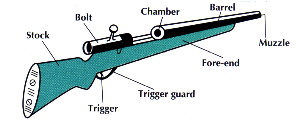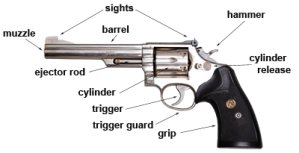I once spoke with a gunsmith about the usual issues that people had brought to him concerning their malfunctioning weapons. The owners often went out for a day of shooting and then suddenly, the rifle or pistol jammed on him or her. These particular pistols and rifles were hardly ever used tools, or the owners stored them in some closet, basement or garage structure.
The owners had hoped that the weapons would work, but often the guns seemed to not function at the correct times. The gunsmith told me plainly that the main problem was that the owners had just forgot to clean their rarely used weapons. The gunsmith had to charge them a steep fee for working on the guns – but a good cleaning, after such a long time of non-use, might have avoided those gunsmith visits.
After a fun day of shooting with friends, or plinking at old cans, bottles, metal boxes and broken televisions in the desert, I used to dread the cleaning ritual. I didn’t like the process of having to check my guns, once again, for any live rounds in the chambers, and then the full disassembly process of the weapons. With my rifles, sometimes a little spring piece would jut out of nowhere and fall somewhere on the floor. Looking for that annoying, tiny piece on the floor somewhere – bothered me greatly.
And then it was the straight on cleaning, with the barrel cleaning taking up most of my time. The worst part was the reassembly because I always had trouble fitting the bolt back into the action of the rifle chamber. In the past, I ‘ve had to call friends over my place, so they could help me out with such mundane tasks.
Recently however, I have overcome the dread of cleaning my weapons. Part of this transformation was due to recognizing the natural, human laziness in doing any cleaning at all. For those of us that enjoy cooking, the washing up and drying of cookware, plates, cups and utensils is not that much fun either. But this is a part of living, and cleaning is one of the actions of light that brings us more peace and happiness.
We clean our anuses and ass cheeks after excreting feces, so we material beings also need to clean our tools for whatever purposes after having used them. We can also embrace cleaning as a virtuous art in itself.
Yes, it takes up time and the wiping actions are quite monotonous, but it is simply another stage in our lives. We can do our cleaning well and thereby, keep using our tools, shelters and bodies in good health. Cleaning is an honorable act of accomplishment. It signifies our basic love for ourselves, where we currently reside, and the instruments in our lives that are important to us.
Before I buy a weapon, I always ask the seller to show me how to clean the thing. I have found that weapons cleaning has helped me learn more about that particular weapon. While I clean the different parts, I can see how the firing pin hits the brass or steel cartridge, how the guide rod helps engage the bolt and the round, how the hammer cock moves the trigger, how the slide assembly moves the bolt, or how the trigger aligns with the action chamber.
This is the most important lesson with cleaning the weapon. The more we clean our weapons, the more accustomed we become to disassembly, viewing the different mechanisms in firing, and reassembly. We transform ourselves into the experts of our very own tools for the martial arts. If we were to engage with live firing during a red alert scenario, then we would feel a lot more comfortable in using our chosen guns. I could not imagine the horrible feeling of dread, while using an unknown weapon during hot combat. Cleaning the weapon will kill that dread.
Before cleaning our weapons, we could set up a special section for the cleaning. Gunpowder, lead and grease will spill and fall out, so we need some backup surfaces for the work. I normally lay out some old fabrics on the table. I also put on elastic hand gloves, to avoid the lead residue getting all over my hands.
I make sure the weapon’s safety is on. I lay the weapon horizontal on the fabrics, with the barrel muzzle facing out, towards a wall facing the outside, (not someone else’s apartment or house), and I grab the weapon’s manual user’s guide. I look up disassembly.
I next move the slide back and check the chamber to see if there is possibly a live round inside. In the past, I have discovered live rounds in the chamber before cleaning, so this is an important and necessary step. After double-checking the safety in the on position and making sure the chamber is free of rounds, I disassemble the weapon. I have found that disassembly is a lot quicker than the reassembly.
Once the weapon is completely disassembled, I lay the different parts out on the fabrics, and then I grab the necessary cleaning tools from the gun cleaning kit. The first thing to clean, and the hardest, is the barrel bore since it has the lead and gunpowder residue inside of it. For the barrels, I now use bore snakes, which are long fabrics that you put in the bore of the rifle, while sprinkling a little gun cleaning oil on the fabric. You pull the bore snake line from the barrel muzzle end, (where the bullet exits), for cleaning. I have had to do this method a couple of times for a good clean. I next inspect the barrel from the muzzle end, in the light, to see if the bore is clear of dirty obstructions. For handguns, I use a thin rod with a brush on the end. I put a little oil on the brush and move it back and forth inside the bore.
Around the barrel and receiver chamber, I use a gun cleaning toothbrush with a little gun oil. I try to get rid of the black soot crap. Following this, I use small white pads with a little oil around the area. I also like to use Q-Tips in the hard to reach spots. At the end, I like to pass a clean white pad, and later, clean Q-Tips around the whole barrel and receiver part. When I feel the whole barrel complex is free from most of the soot, I then move to the bolt.
I clean the bolt with the gun cleaning toothbrush and a little oil. Afterwards, I rub the oiled white pads and Q-Tips on it, and especially around the firing pin area to get rid of the real dirty areas. For the revolvers, I clean the cylinder chambers with a round wire brush and gun oil. I gently wipe around the revolver’s ejecting rod.
I also lightly clean the breech, (the back of the gun), hammer-trigger assemblies, slides, and guide rod-coils with a bit of oil, some white pads, and Q-Tip rubbing. The last part I clean is the whole rifle or handgun, including the stock, the forestock, the magazine area, and the trigger guard with a little oil and some white pads. Finally, I wipe down the different parts with a silicone cloth that gives the weapon a nice, overall clean look.
Now comes the hard part – reassembly. For handguns, this part is not that hard, but for rifles, I usually have my issues inserting the bolt properly into the action chamber area. Although, the reassembly is sometimes frustrating, the practice of reassembly makes the gun owner a better handler of the tool. I have gotten faster in my reassembly skills over the years.
Once the rifle and handgun is fully assembled, check to make sure the slide or pump, and the bolt move easily in the action-chamber. I always do a final wipe with the silicon cloth around the whole weapon. I check to make sure that the safety is still on, thereupon, I lock the weapon and store it in a safe place.
During this whole cleaning ritual, I always reexamine the cleaned parts. Once I view the completely cleaned weapon, which is ready for storage, a great feeling washes over me. I have taken care of my precious tool. This is not an act of love for my guns, but an act of love for being a good artist. A good artist cherishes his or her instruments for both creation and destruction. This is part of the magic of life – expertise in handling tools.





